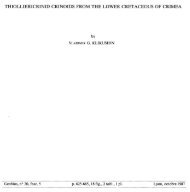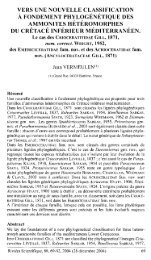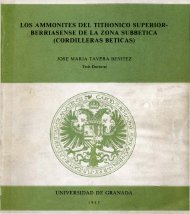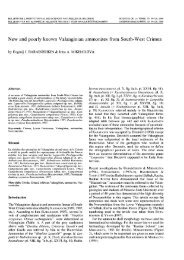peter franklin rawson, dennis curry, frank charles dilley, john michael ...
peter franklin rawson, dennis curry, frank charles dilley, john michael ...
peter franklin rawson, dennis curry, frank charles dilley, john michael ...
Create successful ePaper yourself
Turn your PDF publications into a flip-book with our unique Google optimized e-Paper software.
Subdivision of the Coniacian stageFollowing de Grossouvre (1895-1901) the Coniacian is divided into two ammonitezones:Paratexanites emscherisBarroisiceras haberfellneriAt present, it is difficult to fit these into the British succession (see above). Divisionsbased on Micraster have been recognised in southern England (see Peake inHancock, editor, 1972; Stokes 1975).The SantonianCoquand (1857) named this stage after the village of Saintes in the Charentevalley (Charente Maritime), but in the course of several papers he mentioned avariety of sections in ‘soft chalk with flints’, not only around Saintes but also in thevalley of the Dronne (Charente). The sequence comprises yellowish-white marlychalks, bryozoan-rich chalks and limestones with flints, with hardgrounds andoyster-beds at some levels. The macrofauna is rich and varied, but generally poorlypreserved; the microfauna is richer than that of the type Coniacian, but it is depletedin planktonio elements, and arenaceous forms predominate. At the present time it isnot possible to determine the faunal base of the stage in the stratotype area, nor canits upper limit be established. Seronie-Vivien (1972) considers that the base of theSantonian is marked by the appearance of a distinctive Daviesina, and Globotruncanacf. bulloides and G. lapparenti lapparenti occur some 11m above the base atJavrezac (Seronie-Vivien 1972, p. 32).Based on the Santonian succession in the Corbieres (Aude), de Grossouvre(1895-1901) recognised two ammonite zones:Placenticeras syrtaleTexanites texanusBoth zonal indices have been found in the immediate vicinity of Saintes (Seronie-Vivien 1972, p. 136).De Grossouvre (1895-1901) equated the Santonian stage with the upper part ofthe Craie (Zone) a Micraster coranguinum and the Craie (Zone) a Marsupites of theParis Basin. Using non-ammonite elements of the faunas, it can be established thatthe Aquitanian Santonian can be correlated with the Santonian portion of the Craiede Villedieu in Touraine, which itself is in part the lateral equivalent of theMarsupites Zone (here presumed to include the equivalent of the English Uintacrinussocialis Zone) of the northern part of the Paris Basin. Following this correlationof de Grossouvre, English geologists regard the Marsupites Zone as Santonian,and take the base of the succeeding Campanian stage at the base of the overlyingOffaster pilula Zone.The zones currently used in England are:Marsupites testudinariusUintacrinus socialisMicraster coranguinum (pars)
















